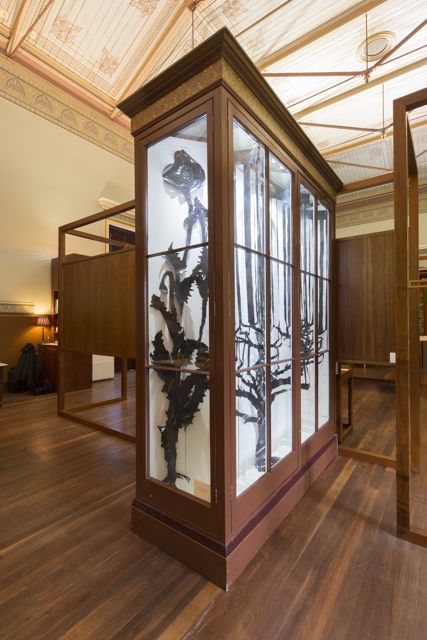Plants and people, Museum of Economic Botany
by Tony Kanellos
Überplants and super plants – civilizations have depended upon them for millennia. Be it wheat or rice or opium and the like, important plants have been the basis of civilisation since the Neolithic revolution.
The need for food, fibre, medicine, dyes, arts, craft tools, weapons, shelter and fuel has been a driving force in our Enquiry into plants.1 This formal Enquiry dates back to Theophrastus in classical Greece and as a result leads us to the cultivation, stewardship and utilization (and often exploitation) of plants.
Hosting this exhibition, Urpflanze street plants, in the Santos Museum of Economic Botany is significant. The gold-leaf lettering identifying the “Museum of Economic Botany” in the Adelaide Botanic Garden provides a catalyst for an important conversation about the nature of our relationship with plants. Caroline Rothwell’s work takes this discussion to other places.
The gold instantly forces our minds to think about wealth and in the context of this museum we are ultimately led to consider cash crops and the Colonial implications. True as that may be there is another layer to the origins of this Museum – the notion of the Economy to Nature.2
When the Museum opened in 1881, Adelaide Botanic Garden director Richard Schomburgk’s supporter Albert Molineux described his interpretation of the Museum:
My idea is that, as every botanical exhibit in the Museum has a use and value to mankind, the word [economic] is most appropriate since they show what use can be made of various plants, and thus waste can be prevented. I do not intend to write a dissertation on the value of economy, but think it would be well were every one to study how to prevent waste and make the most of everything that comes their way. By ‘studying economy’ as illustrated in this museum they may in time learn to ‘live like lords’.
The Museum of Economic Botany was an Adelaide institution involved in the local issues of acclimatisation, crop trials, learning from other cultures. Its role with the Botanic Garden was to plant the Colony – suggesting crops for cultivation to meet local and future needs. Learning from other cultures was paramount.
Caroline Rothwell’s work takes this conversation to other places. Trees constructed of black PVC – Newton’s Tree, Lexicon Poppy (crop) and Lexicon (office plant) clearly contradict the warmth and richness of the plant materials overflowing from within the Museum’s historic cabinets. PVC seems be the antithesis of the material culture of this space but it is worth noting that while PVC is a product of the petrochemical industry, fossil fuels were once plants too.
The formal placement of Newton’s tree reminiscent of the Tree of Knowledge is in the direct gaze of the 1880’s bust of Sir Isaac Newton sitting atop of the tall display cabinet. The busts of “Scientific men” looking down on the museum and its visitors was Schomburgk’s decorative touch – an acknowledgement that his new Museum was a place of science. Knowledge and Science. What is the cost of traditional western science? The systematic classification of the plant world comes at a price – sometimes the collateral damage is discarding of traditional knowledge or the wisdom of non-western knowledge paradigms.
Rothwell’s Lexicon Poppy (crop) could easily be the subject of its own exhibition. The story of opium dates back thousands of years and appears the 1st Century AD Materia Medica of Dicoscorides.3 The stories are many : exploitation of plants; translocation of plants; cash crops; trade – legal and illegal; opium wars; medicine and pharmacology. The dichotomy of the benefits of Morphine (and Coedine) and the ills of Heroin is anchored by the quest for wealth (and health).
Today the role of Santos Museum of Economic Botany is partly that of a “Museum of a Museum” but also, more importantly, in taking the plant world as its muse and encouraging a discussion. In Urpflanze Street plants Caroline Rothwell has shown us the relationship of plants and people through a different lens and it makes for a thought provoking conversation.
Tony Kanellos
Curator Santos Museum of Economic Botany
Notes:
- Enquiry into plants or Historia plantarum is an ancient Greek text written by Theophrastus (the successor to Aristotle at the Lyceum). It was published in a Latin translation in the 15th and 16th centuries, and is a key text for botanists.
2 Carl Linnaeus’s dissertation The Oeconomy of Nature, ostensibly written by his student Isaac J Biberg in 1749.
3 Diocorides Materia Medica is a precursor to all modern pharmacopeias, and is one of the most important herbal books in history, being widely used until the 17th Century.
